
Icicles and rooftop snow dimples provide clues about how we waste energy. At times they can read like a book pointing to ways we can cut energy use, be more comfortable, save money and reduce our impact on the environment.
eMERGE walked through a Guelph neighbourhood ‘reading’ rooftops to identify common issues that make our homes so leaky.
__________
Poor insulation and air sealing can cause warm moist air from our homes to pass through our attics, ceilings and walls. When this happens snow can melt and ice can form. Frequently this also causes something called ice damming. Left unchecked this can cause mold to form and long term damage.
Home 1
The dimples on this roof suggest that the second floor has a partially sloped ceiling with little insulation in it. Warm moist air will work its way through the sloped ceiling and condenses on the underside of the roof. That moisture eventually finds its way to the bottom of the roof forming icicles.

While the icicles might not be so pronounced on this roof, a very large portion of the snow has melted from warm moist air.
Home 2
Even expensive homes can be poorly insulated.
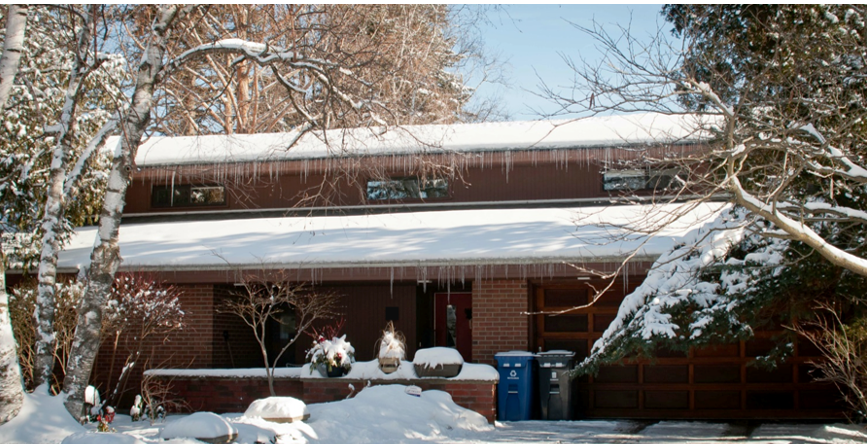
From the quantity of icicles, this one appears to have a second floor cathedral ceiling that is poorly sealed and insulated. It is puzzling that there are also icicles in front of the garage. We normally don’t heat our garages, but this one could be partially heated for workshop space or have poorly insulated heating ducts running through the garage causing warm moist air to escape.
Home 3
A dormer (a roof section that projects vertically beyond the plane of a pitched roof) is often very difficult to air seal and insulate properly. This one has the added challenge of two dormers.

There appears to be a bathroom on the right dormer based on the amount of snow dimpling and the vertical plumbing stack that is usually located in areas where water faucets are situated. As the snow melts in and around the dimples, it eventually forms the corner icicles.
You’ll also notice that the porch (that isn’t enclosed or heated) on the left side has a thick level of snow without any evidence of melting or icicles.
Home 4
The impact of the dormers on icicles formation can clearly be seen especially on the right side of this home.
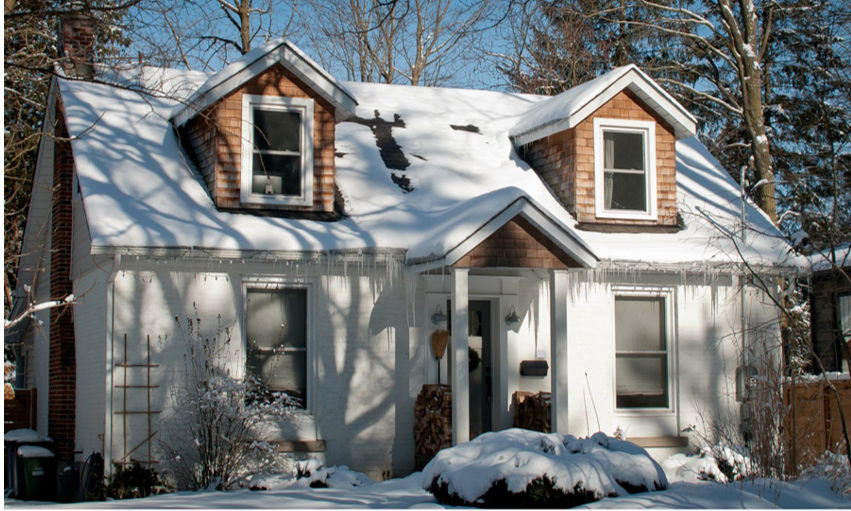
The large dark area between the dormers could be a bathroom, but it might also be an area where some renovation took place that impacted the insulation and air sealing.
Home 5
The large horizontal dark area on this roof is evidence of a poorly insulated and sealed sloped wall/ceiling on the second floor of this house.
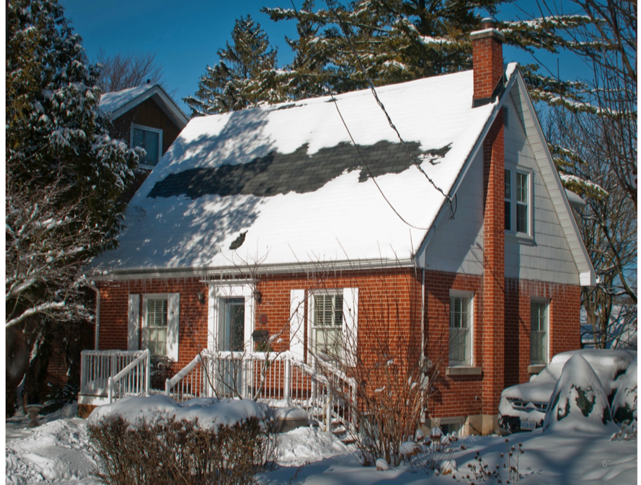
Reinsulating and air sealing from the inside this house could be very difficult and costly. Another option might be to do the work from the outside when the roof needs to be replaced. The incremental cost of removing parts of the wood under the shingles to do the work could reduce the cost. The small dark area immediately above the front door is likely a place where wiring punctures the ceiling and insulation making it easy for warm moist air to make its way into the attic.
Home 6
Heritage homes provide greater challenges when we want to mitigate heat loss.
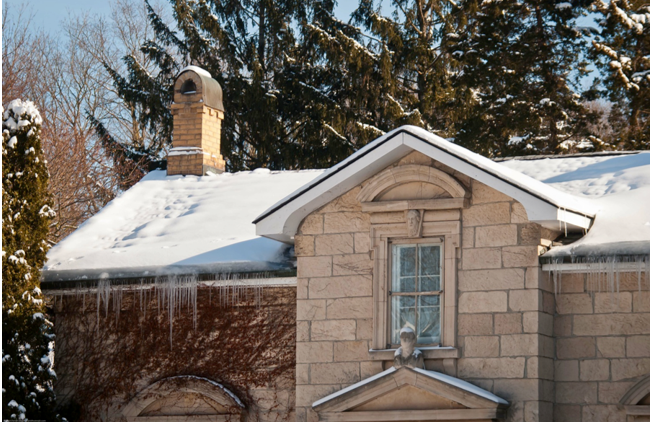
The upper floor in this home has substantial heat loss emanating from the attic. Given that the snow patterns are not consistent across the roof, this could be due to areas of the attic where insulation is missing or was moved for some reason. This home would likely benefit from more attic insulation.
Home 7
This one couldn’t be more picture perfect – but not in a good way.
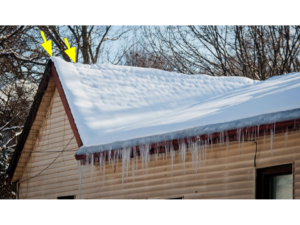
The dimples on the roof tell us that the attic space below it has little or no insulation in it. Of course, the moisture from all of the melting eventually winds up as icicles. The striking thing to see here is how much thicker the snow is between the two yellow arrows (left peak of the roof). This area of the roof is outside of the home and has little heat from below to melt it allowing the snow to remain thicker than the rest of the roof.
Home 8
Snow dimpling on this roof definitely identifies that the third floor has a sloped ceiling with significant heat loss.
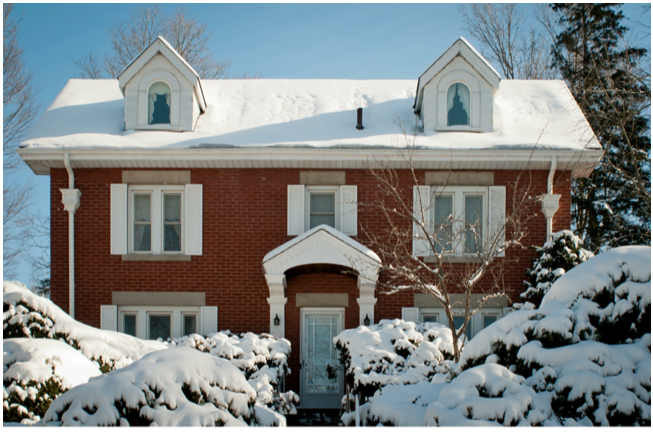
While there is ice buildup along the eaves trough, it hasn’t turned into icicles – yet. The plumbing stack and small second floor window below it probably identify a bathroom above the front door. Bathrooms generate the largest amount of warm moist air inside our homes and can also impact roof patterns that we see.
Home 9
This bungalow appears to have limited – but uniform – insulation above the living space.
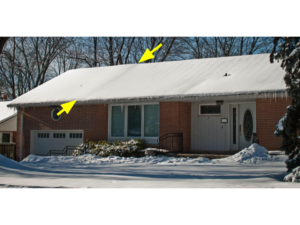
We can see snow that has consistently melted from right to left until you get to the garage (transition occurs at the yellow arrows). Here the snow hasn’t melted because it’s unheated and at a similar temperature to the outside. Thicker snow over the garage means less melting (see Home 7 where the edge of the roofline has thicker snow) ). Note the definite line and difference in snow thickness between the living space and the garage.
Home 10
The heavy melt area in the middle of the roof is almost certain to be a bathroom emitting warm moist air into the attic space and melting the snow.
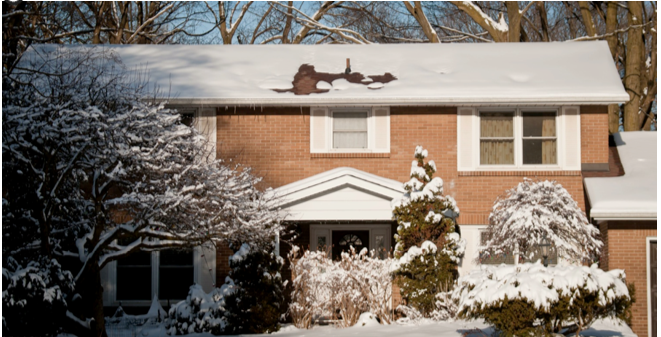
Also noticeable are a few deep snow dimples in different places on the roof. These are usually indicative of wiring that pokes through the ceiling causing a small ‘chimney’ permitting warm air and moisture to escape from these locations.
Home 11
Don’t try this at home kids!

This homeowner has placed electric heating cables on the roof to ‘prevent’ icicles and ice damming. This approach masks the real problem, doesn’t prevent ice damming, will cost you more money on your hydro bill and potentially damage your shingles over time. It actually looks like this homeowner may have improved the attic insulation over time but didn’t bother to turn off the heating cable. At eMERGE we have even seen homes where these cables are left on year round causing even more roof damage.
Home 12
And finally, here’s a home that appears to be reasonably well insulated. Nice and clean eh?
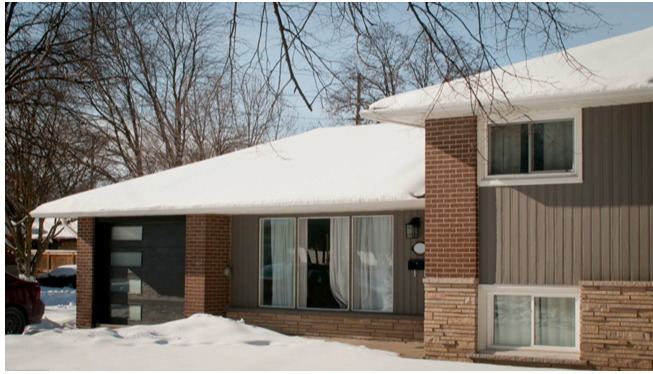
Note: Many homes in Guelph have similar challenges and these photos are for illustrative purposes only. We have removed street numbers and any other identifying information about these homes.
Snow patterns on rooftops change throughout the winter and are impacted by a lot of influences. They aren’t always noticeable and these images only give us a starting point at identifying the areas in our homes that need attention.



Hi,
this is a great start of a new approach to communicate with home owners. Hopefully you can at one point list examples&data of the non-monetary benefits of energy-retrofitting residential homes.
Cheers,
Ernst
This is awesome. I was noticing the two houses across the street from me-one with abundant snow on the roof and the other without much at all and comparing to mine (attic insulation scheduled but not done). Then I noticed the big differences in other houses in my neighbourhood, and thought that a knowledgable person could tell a lot about the insulation of these houses by looking at the roof this time of year. And yes, here it all is! Thanks Emerge, our city is blessed to have you.